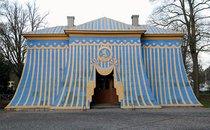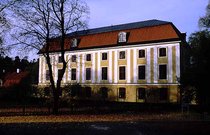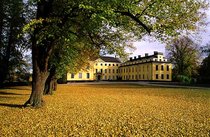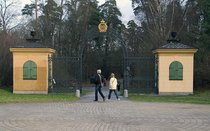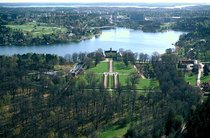The National City Park
The first national city park in the world spreads across Norra and Södra Djurgården. It contains royal palaces and parks, museums and a university, together with a wide diversity of plant and animal life, right on the doorstep of the capital.
The basis of the national city park is “Djurgårdsmarken”, now known as Norra and Södra Djurgården, which has been royal land since late mediaeval times. And it is also kings who have contributed in various ways, giving the area its special character today, dominated by palaces and parks. Djurgården’s beautiful and pastoral landscape has been the most popular area for Stockholmers to come for outings, walking and leisure since the 18th century.
The National City Park was formed in 1994 in order to protect the Ulriksdal-Haga-Djurgården-Brunnsviken area, in the municipalities of Stockholm, Solna and Lidingö. The law states that “new buildings and new facilities are constructed and other actions taken only if this can take place without violation of the park landscape or natural environment, and without other damage to the natural and cultural values of the historical landscape.”
Djurgården
The name “Djurgården” (literally “the animal park”) arose since the area was the fenced royal hunting area at Stockholm for a long period, starting in the 16th century. During the 1570s, King Johan III laid down the first animal park, with reindeer, red deer and elk. Karl XI fenced off the complete area of Norra and Södra Djurgården 100 years later, as a hunting park. In the middle of the 18th century, King Adolf Fredrik, who was not particularly interested in hunting, opened Djurgården for outings and leisure activities. During this period, the area came to be transformed into picturesque parks, associated with the royal palaces at Ulriksdal, Haga and Rosendal.
Royal palaces and parks in Norra Djurgården
The royal palace at Ulriksdal is on the shores of Edsviken in Norra Djurgården. The origin of Ulriksdal is in the Jakobsdal manor house, built by Count Jacob De la Gardie in 1638. In 1669 the queen dowager Hedvig Eleonora purchased Jacobsdal. The palace was given its current name when the queen subsequently bestowed it as christening gift to hew newly born grandson, Prince Ulrik, brother of Karl XII. However, Ulrik died when he was only one year old, and the property returned to Hedvig Eleonora. She then arranged for new wings, designed by Nicodemus Tessin the Elder, to be built. Around 1705, the Orangery was built in the palace grounds. This had been designed by Nicodemus Tessin the Younger, and is today a museum of sculpture. Queen Ulrika Eleonora spent much time at Ulriksdal and rebuilt the palace to give it its current baroque exterior
The building at Ulriksdal known as “Confidencen” was originally riding stables, and was converted to a theatre in 1753. Gustav III together with troubadour Carl Michael Bellman spent time here, enjoying themselves and giving others pleasure. The theatre has reopened in recent years and plays and ballets are performed here in the summer.
Haga is considered to be one of the finest English landscape parks in the world, and it is one of the best preserved historical parks in Sweden. The park was the initiative of King Gustav III, who was heavily influenced by the romantic ideas of the time focusing on the delights of the natural world. The great landscape architect of the era, Fredrik Magnus Piper, was commissioned to plan what was then known as an “English landscape park”. The result was rolling lawns alternating with dark forest, and half-open pastures. Meandering paths led the visitor past shrubbery, bowers, newly built ruins, and pavilions. More than 25,000 trees were planted. The great lawn, known by the French word “pelouse”, was laid down, to be used as an amphitheatre. A further three English landscape parks were constructed on royal initiative at Brunnsviken, one in the north at Tivoli, one in the east at Frescati, and one of the south at Bellevue.
Gustav III had grandiose plans for Haga, including a grand palace in classical style with theatre, library and art galleries. The foundation was laid in 1786,and the following year construction of the Koppartälten (“Copper Tent”) started. The Gustav III Pavilion was completed shortly before Gustav’s death, but the king’s death resulted in construction of the palace being halted. Today, all that remains of the planned palace are the impressive rock foundations. The Haga Palace, previously known as “Drottningens paviljong” (“The Queen’s Pavilion”) was built 1802-1804 in Italian villa style following a design by CG Gjörwell. Several royal personages lived in the palace, up to the end of the First World War. Crown Prince Gustav Adolf with his consort Sibylla moved into the palace in the 1930s, and it was here that the four “Haga princesses” were born, as was also Sweden’s current king, Carl XVI Gustaf.
Also located at Norra Djurgården is Stallmästaregården, which is the oldest out-of-town restaurant preserved in the Stockholm region. It has been in uninterrupted operation since the middle of the 17th century. The grounds retain the character they were given in the 1740s. A set of six large murals by artist Hilding Linnqvist showing events from the work of Bellman was painted in 1946 in the main hall.
Just north of Stallmästargården is Haga tingshus (“Haga Courthouse”), which was built in 1905-1907 in German art nouveau/baroque style. The building is well preserved and situated in a beautiful park, with a wooden fence and large stone gateposts.
Norra Djurgården is also a place for higher education. The Bergian Garden was established at Frescati in the 1880s, and was followed in the 1910s by the Veterinary College, the Royal Swedish Academy of Sciences, and the College of Forestry. The Swedish Museum of Natural History was also built around this time, in association with these institutes of higher education. Stockholm University moved from central Stockholm to Frescati around 1970. The main building is a modernist construction with a light-blue glass facade, now known as the “Southern House”, and was built in 1968-71.
Museums and amusements in Södra Djurgården
The first park that was established in Södra Djurgården was built by a merchant, Carl Magnus Fris at the end of the 18th century. The park lay east of Waldemarsudde. During the first half of the 19th century, Karl XIV Johan had built an out-of-town residence at Rosendal in Södra Djurgården. At the same time, the king restructured the peninsula to a pastoral and park-like landscape through felling many trees and the extensive planting of new ones, both domestic species such as oak, beech, elm and maple, and imported species such as larch, horse chestnut and the common lime. Södra Djurgården was now becoming a popular leisure location for the wealthy bourgeoisie in Stockholm, while the working class kept themselves to Norra Djurgården.
Rosendal Palace was built in 1823-1826 as royal summer residence for Karl XIV Johan, following a design of Fredrik Blom, one of the most distinguished architects of the day. A relatively austere and simple Swedish variant of empire style, known as Karl Johan, was used. The palace was manufactured as a prefabricated house, a technique that the architect himself had developed. This technique roused international attention, and Fredrik Blom exported several houses to other countries. Today, Rosendal Palace is one of the best preserved examples of Karl Johan style in Sweden, both with respect to the architecture and the furnishings. Stiftelsen Rosendals Trädgård has cultivated the gardens and operated a café at the palace since 1983. Guided tours of the palace are arranged during the summer.
During the 19th century, the area known as Djurgårdsslätten at Södra Djurgården became one of the most popular leisure areas for Stockholmers. The first funfair opened here in 1850, in front of what is now the main entrance to Skansen. This funfair was later replaced by Gröna Lund, opened in 1883. Cirkus is, as the name implies, a building initially intended for circuses, now used for performances of many types. It was opened in 1892.
Södra Djurgården came to be characterised to a large extent during the 19th century by the summer villas and gardens built by wealthy city-dwellers along the shores of the peninsula. These buildings were later converted to year-round homes, while other large villas, such as the palatial Waldemarsudde of Prince Eugen and the Thielska Gallery, were built.
The first museum on Södra Djurgården was Nordiska Museet, intended for Swedish cultural history. Construction started in 1889 following a design of Isak Gustaf Claeson, one of the period’s great Swedish architects. The building was completed in 1907 in a style that can best be described as northern European 17th century renaissance, and it is today one of the most monumental buildings in Stockholm. At the same time as Nordiska Museet was being built, Skansen, the world’s oldest open-air museum (1891) was founded, as was the Biological Museum (1893). The world-famous Vasa Museum with the unique royal ship Vasa, which sank in 1628, was opened next to Nordiska Museet in 1990. Further museums have been opened not only in the parks of Norra Djurgården, where the National Museum of Science and Technology, the Museum of Ethnography and, most recently, the Riksidrottsmuseet (sport), and the Police Museum opened in 2007, but also on Skeppsholmen, where the Museum of East Asia, Moderna Museet and the Swedish Museum of Architecture are located.
The natural world is also an important part of the National City Park. The park presents a cross-section of many types of natural environment found in central Sweden such as deciduous and conifer forests, wetlands, lakes and watercourses, waterfronts and islands. The many oaks and stately deciduous trees bear testimony to the history of Djurgården as royal hunting park.
A cycle map and visitors’ guide in PDF format can be downloaded from the website of the National City Park (www.nationalstadsparken.se/besök).

